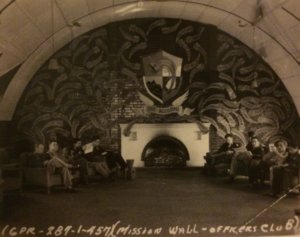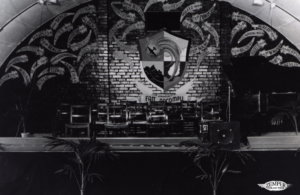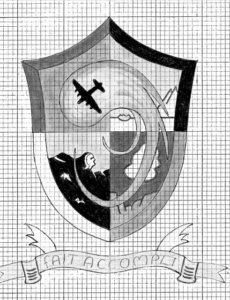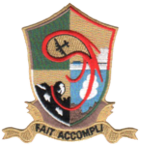
The ‘Coat of Arms’ or groups insignia for the 457th Bombardment Group has never been officially approved by the office of The Quartermaster General in Washington D.C.. Although it has never been officially approved it has been used for many years. The group was re-activated twice.
The first time it was (re-)activated during July 1st 1993 – October 1st 1994 and named the 457th Operations Group. It was an operational component of the 19th Air Refueling Wing, with its headquarters at Altus AFB, Oklahoma. The 457th operated the 11th Air Refueling Squadron and 306th Air Refueling Squadron, flying KC-135R Stratotankers in Southwest Asia from Aviano Air Base, Italy, and Incirlik Air Base, Turkey; supporting Operation Northern and Operation Southern Watch duties as the lead tanker unit.
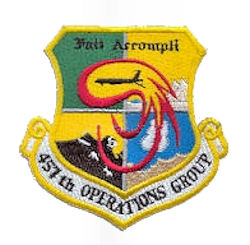
Emblem 457th Operations Group
The 457th Air Expeditionary Group was (re-)activated as a combat unit as part of the Global War on Terrorism, to support Operation Iraqi Freedom. It is known that the group supported B-52 Stratofortresses operations, using B-52Hs attached from the 23d Bomb Squadron, Minot AFB, North Dakota, and USAF Reserve 917th Wing, Barksdale AFB, Louisiana. The B-52s operated from a “forward deployed location”, which was RAF Fairford, England. The unit inactivated sometime after Operation Iraqi Freedom ended active combat operations.
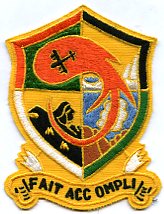
Emblem 457th Air Expeditionary Group
INFORMATION
Lineage
It was constituted as 457th Bombardment Group (Heavy) on 19 May 1943, and activated on July 1st 1943, trained for combat with B-17’s, moved to England from January – February 1944, and assigned to Eighth AF. They flew their first mission on February 21st 1944 during Big Week, taking part in the concentrated attacks of heavy bombers on the German aircraft industry and until June 1944 they were engaged primarily in bombardment of strategic targets, such as ball-bearing plants, aircraft factories, and oil refineries in Germany. They bombed targets in France during the first week of June 1944 in preparation for the Normandy invasion, and attacked coastel defenses along the Cherbourg peninsula on D-Day, also stricking airfields, railroads, fuel depots, and other interdictory targets behind the invasion beaches throughout the remainder of the month. They soon resumed bombardment of strategic objectives in July 1944 and engaged chiefly in such operations until April 1945. Sometimes flying support and interdictory missions, aiding the advance of ground forces during the St. Lo breakthrough in July 1944 and the landing of British I Airborne Division during the Airborne attack on Holland in September 1944; and participating in the Battle of the Bulge, December 1944 – January 1945, and the assault across the Rhine in March 1945. They flew their last combat mission on April 20th 1945 and transported prisoners of war from Austria to France after V-E Day. They Returned to the US in June 1945 and inactivated on 28 August 1945.
Squadrons
748th: 1943 – 1945
749th: 1943 – 1945
750th: 1943 – 1945
751st: 1943 – 1945
Stations
Geiger Field, Wash, 1 July 1943; Rapid City AAB, SD, 9 July 1943; Ephrata AAB, Wash, 28 October 1943; Wendover Field, Utah, 6 December 1943 – 1 January 1944; Glatton, England, 28 January 1944 – June 1945; Sioux Falls AAFld, SD, July 28 – August 1945
Commanders
Colonel Herbert E. Rice, 24 July 1943; Lt. Colonel Hugh D. Wallace, 3 September 1943; Colonel James R. Luper, 4 January 1944; Colonel Harris E. Rogner, 11 October 1944 – August 1945
Campaigns
Air Offensive, Europe; Normandy; Northern France; Rhineland; Ardennes-Alsace;Central Europe.
Decorations
None
Emblem
None
The following information was written by Ken Blakebrough and it’s from his book “The Fireball Outfit”
A shield with a scroll and the words “Fait Accompli” below it. The shield itself is divided into four sections, each of which represented a station through which the Group had passed in coming overseas. The outline of a B-17, leaving a flaming red trail, is shown passing through each quarter until it reached the skies of combat in the upper left portion of the shield.
It was this B-17 with it’s fireball trail that gave the 457th it’s popular name; The Fireball Outfit
The mission wall at the officers club with the 457th insignia in the middle made by corporal Lester Fried
Same photo as above but now there is a stage in front of the wall
Drawing of the ‘Coat of Arms’


